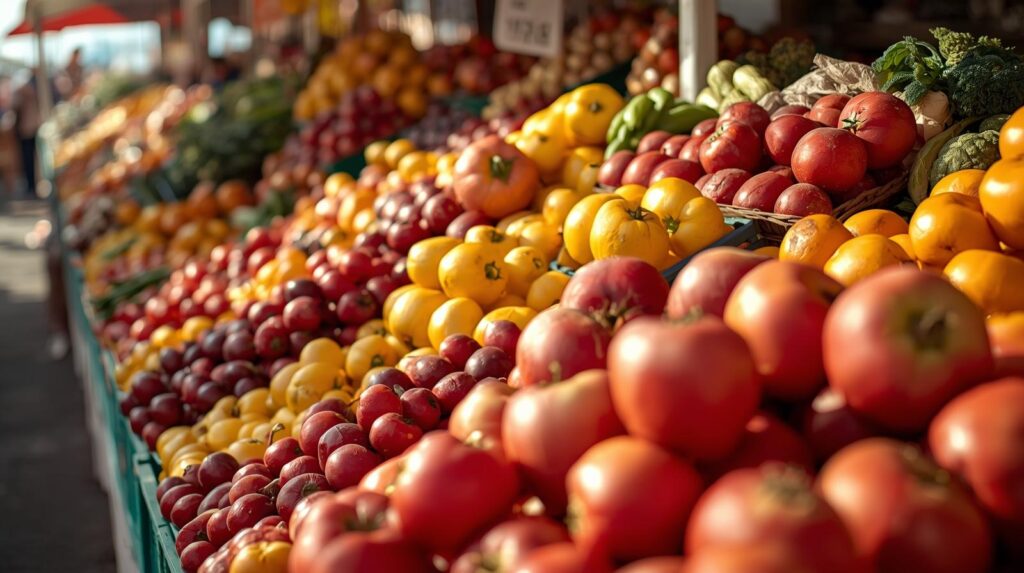By The Digital Hustle Hub
Grocery shopping in a big city feels like a wallet ambush—$15 for a tiny bag of produce or $5 for a loaf of bread. I’ve been there, hustling through freelance design gigs in a pricey urban jungle, shocked at how fast my grocery bill ate up my Upwork cash. In 2025, with city rent averaging $2,000, groceries up 10%, and side hustle income from platforms like Etsy or TaskRabbit coming in uneven spurts, saving on groceries is a must for urban professionals. These strategies cut your food bill without leaving you eating ramen every night.
In this guide, I’m sharing seven practical ways to save on groceries in big cities, pulled from my own shopping hacks and stories from friends who’ve cracked the code. Each includes why it works, how to do it, and what you’ll save, with steps for busy city hustlers. Headings are ready for WordPress pasting, because you’re already dodging enough chaos. Ready to shop smarter and keep your cash? Let’s dive in.

Why Grocery Savings Are Critical in Big Cities in 2025
Urban life’s a budget buster—city costs are 20% higher than suburbs, per recent stats, and 60% of young pros lean on side gigs to cover bills. With gig platforms reporting earnings to the IRS ($600+), you need savings for taxes or slow months. Groceries can run $300-$400 a month in cities like New York or San Francisco, but these hacks can shave $50-$150 off that, freeing up cash for rent or goals. They’re perfect for remote workers or hustlers who want to eat well without blowing their gig money.
1. Shop at Budget Stores
Why It Works
Fancy markets like Whole Foods charge $10 for a salad mix, while Aldi or Walmart sell it for $3. I used to overspend at trendy stores until I switched and saved $100 a month.
How to Do It
Find an Aldi, Walmart, or Trader Joe’s (check Google Maps). Budget $150/month for one person. Stick to basics: rice ($1/lb), beans ($1/can), veggies ($2/lb). Shop weekly to avoid waste. Takes 1 hour/week.
Savings Potential
Saves $50-$100/month, $600-$1,200/year.
A Real Win
My friend Tara, a barista with $200/month Etsy gigs in Philly, shops at Aldi. Cut $80/month from groceries, saved $960/year for a savings account.
Step-by-Step Tips
- Locate Aldi or Walmart (10 minutes).
- Budget $150/month, shop weekly.
- Buy basics: rice, beans, veggies.
- Track savings in a free app like Mint.
2. Plan Meals Weekly
Why It Works
Impulse buys like $5 snacks add up when you shop without a plan. I used to grab random items and waste $30 a month until I started planning meals.
How to Do It
List 5-7 meals (e.g., rice bowls, pasta) on Sunday. Check pantry, buy only what’s needed ($20-$30/week at Aldi). Use a free notebook or app like AnyList. Takes 20 minutes/week.
Savings Potential
Saves $20-$50/month, $240-$600/year.
A Real Win
Jake, a coder with $300/month tutoring in Chicago, plans 5 meals weekly. Saved $40/month, $480/year, for a Roth IRA.
Step-by-Step Tips
- List 5 meals Sunday (10 minutes).
- Check pantry, make a $20 list.
- Use AnyList or a notebook.
- Stick to list at store.
3. Buy in Bulk for Staples
Why It Works
Bulk rice, beans, or oats cost half as much per pound. I buy a $5 bag of rice and it lasts a month, saving $20 over small packs.
How to Do It
Get bulk rice ($5/5lb), beans ($4/4 cans), oats ($4/3lb) at Walmart or Costco (split membership with a friend, $30/year). Store in $5 containers. Takes 1 hour to shop, 5 minutes to organize.
Savings Potential
Saves $20-$40/month, $240-$480/year.
A Real Win
Sophie, a freelancer with $400/month gigs in Austin, buys bulk rice, beans. Saved $30/month, $360/year, for a vacation fund.
Step-by-Step Tips
- Shop bulk at Walmart or Costco.
- Spend $10-$15 on staples.
- Store in $5 containers.
- Use bulk for 80% of meals.
4. Use Grocery Apps for Deals
Why It Works
Apps like Flipp or Ibotta show sales and coupons, cutting $10-$20 off each trip. I started using Flipp and saved $15 a week on veggies and meat.
How to Do It
Download Flipp (free) to compare store sales. Clip digital coupons on store apps (e.g., Target). Spend 10 minutes pre-shop to plan deals. Shop where savings are highest. Takes 15 minutes/week.
Savings Potential
Saves $10-$30/month, $120-$360/year.
A Real Win
Liam, a TaskRabbit hustler with $500/month in Miami, uses Flipp. Saved $20/month, $240/year, for an emergency fund.
Step-by-Step Tips
- Download Flipp or Ibotta (free).
- Check sales, clip coupons (10 minutes).
- Shop at cheapest store weekly.
- Track savings in a notebook.
5. Skip Pre-Packaged Foods
Why It Works
Pre-cut veggies or packaged snacks cost double—$5 for a salad kit vs. $2 for loose greens. I used to buy these for convenience until I saw the markup.
How to Do It
Buy whole veggies ($2/lb carrots), fruits ($1/lb apples), bulk nuts ($3/lb). Chop veggies yourself (10 minutes/week). Pack snacks in $2 reusable bags. Takes 15 minutes/week.
Savings Potential
Saves $20-$50/month, $240-$600/year.
A Real Win
Emma, a creator with $350/month Patreon in Boston, ditched pre-cut produce. Saved $30/month, $360/year, for a laptop.
Step-by-Step Tips
- Buy whole veggies, fruits at Aldi ($5).
- Chop weekly (10 minutes).
- Use reusable bags for snacks.
- Log savings in a budget app.
6. Cook One-Pot Meals
Why It Works
One-pot meals like soups or stir-fries use cheap ingredients and cut cleanup time. I make these to save $15 a meal over takeout.
How to Do It
Cook one-pot dishes (e.g., lentil soup, $2/serving) with $10/week staples (lentils, veggies). Use YouTube recipes, 20 minutes prep. Make 4 servings for leftovers. Takes 1 hour/week.
Savings Potential
Saves $30-$60/month, $360-$720/year.
A Real Win
Tom, a freelancer with $400/month gigs in New York, cooks one-pot chili weekly. Saved $40/month, $480/year, for a course.
Step-by-Step Tips
- Buy $10 staples (lentils, rice, veggies).
- Cook one-pot meal weekly (20 minutes).
- Make 4 servings for leftovers.
- Track savings in a free app.
7. Freeze Extras to Avoid Waste
Why It Works
Food waste costs $20-$50 a month—veggies go bad, leftovers get tossed. I started freezing extras and saved $30 a month.
How to Do It
Freeze leftover meals, veggies, or bread in $5 freezer bags. Label with dates. Use within 3 months. Defrost for quick meals. Takes 10 minutes/week.
Savings Potential
Saves $20-$40/month, $240-$480/year.
A Real Win
Tara, a barista with $200/month Etsy gigs, freezes soup leftovers. Saved $30/month, $360/year, for a tax fund.
Step-by-Step Tips
- Buy $5 freezer bags at Walmart.
- Freeze leftovers, veggies weekly.
- Label bags with dates (5 minutes).
- Use frozen items within 3 months.
Wrapping It Up: Shop Smart, Save Big
These seven grocery hacks—budget stores, meal planning, bulk buys, deal apps, skipping packaged foods, one-pot meals, and freezing extras—are your 2025 guide to slashing food costs in big cities. Save $50-$150 a month, eat well, and keep your gig cash for goals. My friends have saved thousands with these tricks—you’re next.
What’s your first grocery hack? Share below and let’s save cash.
Written by Mudassar Ali — Founder of The Digital Hustle Hub
Helping urban pros shop smart, live big.



